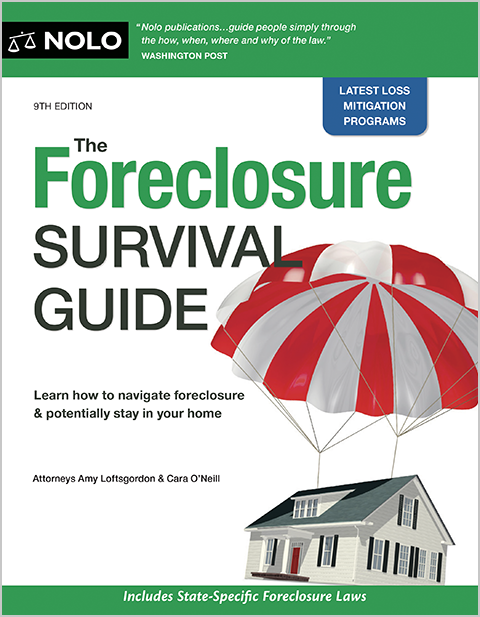Learn about Alaska foreclosure laws.
Federal and state laws regulate loan servicing and foreclosure processes. Most of these laws give protections to borrowers. For example, servicers generally have to provide borrowers with loss mitigation opportunities, account for each foreclosure step, and strictly comply with foreclosure laws.
Also, most people who take out a loan to buy a residential property in Alaska sign a promissory note and a deed of trust. These documents give homeowners some contractual rights in addition to federal and state legal protections.
So, don't get caught off guard if you're an Alaska homeowner behind in mortgage payments. Learn about Alaska foreclosure laws and the foreclosure process, from missing your first payment to a foreclosure sale.
- What Are My Rights During Foreclosure in Alaska?
- What Is Preforeclosure in an Alaska Foreclosure?
- When Can Foreclosure Start in Alaska?
- What Are the Different Types of Foreclosures in Alaska?
- What Are the Steps Involved in the Nonjudicial Foreclosure Process in Alaska?
- How Alaska Foreclosure Sales Work
- What Are the Options Available for Borrowers During Foreclosure in Alaska?
- Are Deficiency Judgments Allowed in Alaska?
- More Foreclosure Information
- Getting Help in an Alaska Foreclosure
What Are My Rights During Foreclosure in Alaska?
In an Alaska foreclosure, you'll most likely get the right to:
- apply for loss mitigation
- receive notice of the foreclosure
- receive special protections if you're in the military
- stop the foreclosure by paying off the overdue payments and bringing the loan current
- pay off the loan to prevent a sale
- file for bankruptcy, and
- get any excess money after a foreclosure sale.
What Is Preforeclosure in an Alaska Foreclosure?
The period after you fall behind in payments, but before a foreclosure officially starts, is generally called the "preforeclosure" stage. (Sometimes, people refer to the period before a foreclosure sale happens as "preforeclosure," too.)
During this time, the servicer can charge you various fees, like late charges and inspection fees, and, in most cases, must inform you about ways to avoid foreclosure, and send you a breach letter (a preforeclosure notice).
When Can Foreclosure Start in Alaska?
Under federal law, the servicer usually can't officially begin a foreclosure until you're more than 120 days past due on payments, subject to a couple of exceptions. (12 C.F.R. § 1024.41 (2025).) This 120-day period gives most homeowners enough time to submit an application for a foreclosure alternative to the servicer.
What Are the Different Types of Foreclosures in Alaska?
If you default on your mortgage payments in Alaska, the lender may foreclose using a judicial or nonjudicial method.
How Judicial Foreclosures Work
A judicial foreclosure begins when the lender files a lawsuit asking a court for an order allowing a foreclosure sale. If you don't respond with a written answer, the lender will automatically win the case.
But if you choose to defend the foreclosure lawsuit, the court will review the evidence and determine the winner. If the lender wins, the judge will enter a judgment and order your home sold.
How Nonjudicial Foreclosures Work
If the lender chooses a nonjudicial foreclosure, it must complete the out-of-court procedures described in the state statutes. After completing the required steps, the lender can sell the home at a foreclosure sale.
Most lenders opt for the nonjudicial process because it's quicker and cheaper than litigation in court.
What Are the Steps Involved in the Nonjudicial Foreclosure Process in Alaska?
Again, most residential foreclosures in Alaska are nonjudicial, with a third party called a "trustee" handling the entire process.
Notice of the Foreclosure
To officially begin an Alaska foreclosure, the trustee records a notice of default in the appropriate recording district not less than 30 days after the default and not less than 90 days before the sale. Then, the trustee mails a copy to you (the trustor in the trust deed) and various other parties by certified mail within ten days after recording the notice. (Alaska Stat. § 34.20.070 (2025).)
Instead of mailing the notice, the trustee may personally deliver a copy of the notice of default to you and the other parties within 20 days after recording it. But if the property doesn't have a structure and no one is present at the time of delivery, the trustee may place the notice on the property. If access to the property is restricted due to road conditions, gates, or other barriers, the trustee may post it as close as practicable to the property. (Alaska Stat. § 34.20.070 (2025).)
The trustee also has to:
- post a notice of sale in three public places within five miles of where the foreclosure sale will happen at least 30 days before the foreclosure sale
- publish the notice in a newspaper once a week for four weeks before the sale, and
- publish the notice on the internet starting at least 45 days before the sale date. (Alaska Stat. § 09.35.140 (2025).)
How Alaska Foreclosure Sales Work
At the sale, the lender usually makes a credit bid. The lender can bid up to the total amount owed, including fees and costs, or it may bid less. In some states, when the lender is the high bidder at the sale but bids less than the total debt, it can get a deficiency judgment (see below) against the borrower.
The property becomes "real estate owned" (REO) if the lender is the highest bidder. But if a bidder, say a third party, is the highest bidder and offers more than you owe, and the sale results in excess proceeds (over and above what's needed to pay off all the liens on your property), you're entitled to that surplus money.
What Are the Options Available for Borrowers During Foreclosure in Alaska?
A few potential ways to stop a foreclosure and keep your home include reinstating the loan, redeeming the property, or filing for bankruptcy. Or you might be able to work out a short sale or deed in lieu of foreclosure and avoid a foreclosure. But you'll have to give up your home.
Reinstating the Loan
In a nonjudicial foreclosure, Alaska law permits the borrower to reinstate (get current on) a defaulted loan at any time before the sale date. But if the trustee filed two or more previous notices of default and the borrower reinstated each time, the trustee can refuse to accept a later reinstatement. (Alaska Stat. § 34.20.070 (2025).)
Does Alaska Have a Foreclosure Redemption Period?
One way to stop a foreclosure is by "redeeming" the property. To redeem, you must pay off the full loan amount before the foreclosure sale.
Some states also provide foreclosed borrowers a redemption period after the foreclosure sale, during which they can buy back the home. But under Alaska law, a foreclosed borrower doesn't get the opportunity to redeem the home following the sale unless the deed of trust expressly gives a right of redemption. (Alaska Stat. § 34.20.090 (2025).)
Filing for Bankruptcy
If you're facing a foreclosure, filing for bankruptcy might help. If a foreclosure sale is scheduled to occur very soon, filing for bankruptcy is the best way to stop the sale immediately. Once you file for bankruptcy, an "automatic stay" goes into place. The stay operates as an injunction, prohibiting the lender from foreclosing on your home or trying to collect its debt, at least temporarily.
In many cases, filing for Chapter 7 bankruptcy can delay the foreclosure by a matter of months. Or, if you want to save your home, filing for Chapter 13 bankruptcy can provide a way to catch up on mortgage arrears through a three- to five-year payment plan. To find out the options available, speak with a local bankruptcy attorney.
Are Deficiency Judgments Allowed in Alaska?
In a foreclosure, the borrower's total mortgage debt sometimes exceeds the foreclosure sale price. The difference between the total debt and the sale price is called a "deficiency." For example, say the total debt owed is $400,000, but the home sells for $350,000 at the foreclosure sale. The deficiency is $50,000.
In some states, the lender can seek a personal judgment against the debtor to recover the deficiency. Generally, once the lender gets a deficiency judgment, the lender may collect this amount ($50,000 in the example above) from the borrower.
Under Alaska law, deficiency judgments aren't allowed following a nonjudicial foreclosure. (Alaska Stat. § 34.20.100 (2025).) (But if the lender pursues a judicial foreclosure, a deficiency judgment is permitted.) (Alaska Stat. § 09.45.180 (2025).)
More Foreclosure Information
For more information on federal mortgage servicing laws and foreclosure relief options, go to the Consumer Financial Protection Bureau (CFPB) website.
Getting Help in an Alaska Foreclosure
If you have questions about Alaska's foreclosure process or want to learn about potential defenses to a foreclosure and possibly fight the foreclosure in court, consider talking to a foreclosure attorney.
It's also a good idea to talk to a HUD-approved housing counselor to learn about different loss mitigation options. You can use the CFPB's Find a Counselor tool to get a list of HUD-approved housing counseling agencies in your area. You can also call the Homeownership Preservation Foundation (HOPE) Hotline, which is open 24 hours a day, seven days a week, at 888-995-HOPE (4673).
- What Are My Rights During Foreclosure in Alaska?
- What Is Preforeclosure in an Alaska Foreclosure?
- When Can Foreclosure Start in Alaska?
- What Are the Different Types of Foreclosures in Alaska?
- What Are the Steps Involved in the Nonjudicial Foreclosure Process in Alaska?
- How Alaska Foreclosure Sales Work
- What Are the Options Available for Borrowers During Foreclosure in Alaska?
- Are Deficiency Judgments Allowed in Alaska?
- More Foreclosure Information
- Getting Help in an Alaska Foreclosure

